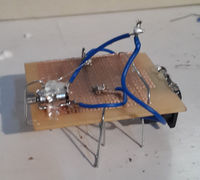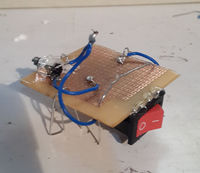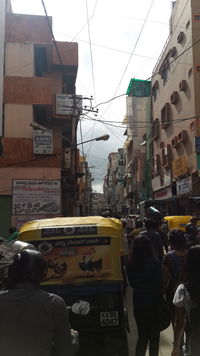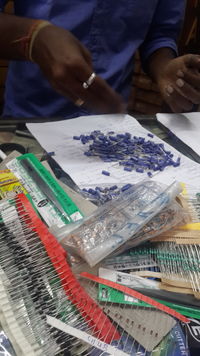Difference between revisions of "Prarthana"
(→Diodes) |
(→Transistors) |
||
| Line 51: | Line 51: | ||
===[[Transistors]]=== | ===[[Transistors]]=== | ||
| − | + | ||
| + | Initially when we made a circuit with transistor, using 22k and 1k resistance, I didn’t quite understand the use of it. Later after some theory and experimentation with LDR did I get to know about it’s amplifying qualities. It was interesting how, instead of one of the resistors we used our body resistance to complete the circuit! Never knew our body had resistance, which could be used in such a way. This idea could be used to make so many cool things, from magic trick toys to just fascinating products and objects. I remember, as a kid, I used to own a lamp, which would light up as you touch it. Now with knowledge of all these electrical components I’m starting to unravel my childhood magic items. | ||
==[[555 oscillator]]== | ==[[555 oscillator]]== | ||
making oscillator, changing inputs | making oscillator, changing inputs | ||
Revision as of 11:40, 17 October 2015
Contents
Micro Robots
Introductory class
Building my own Robot on the very first day kick- started my interest in electronics. Not only did we learn how to build a basic circuit but also how to solder. Soldering makes your work look much neater and also adds the basic strength required within the different components of a circuit. What boosted my learning was the fact that we did all of this practically with minimal theory. I believe that what you learn practically by experimenting is far more effective and deeper than what you learn merely through theory.
This robot had a simple logic behind it; the battery and the switch were connected to a small motor, whose vibration caused the PCB to move. Something that I wouldn’t have thought of, despite the knowledge about how to make these connections to run a motor. While making the robot one of the major difficulties I faced was when one of the motor legs broke after the entire circuit was soldered onto the PCB. In which case I learned how you could de-solder the excess solder on the leg using a de- soldering pump and solder the wire directly to the metal connection on the motor’s body. The other difficulty that I faced was while making the legs of the robot using U-pins. While making the connections on the PCB and securing them using glue gun and soldering, I didn’t think about the holes through which the legs could pass. Due to which I wasn’t able to attach four legs on four corners which would balance the structure. After experimenting a little I attached three legs to the structure in a triangular manner followed by two pseudo legs on the front to maintain balance.
One thing I think I really need to work on is neatness and securing connections. I believe that my robot, to an extent, is still fragile. Also my soldering tends to get messy, which I would get better at as I practice more.
Trip to SP road
It was a very tiring day, but going to this hub of electrical supplies was worth all the physical and mental exhaustion. It was interesting how the entire lane consisted of electrical shops, some big some small. I wondered how the market worked with competition all around you. Why would you place all these electrical stores right next to each other, where you get more or less the same things. But when we went around a couple of stores asking for the list of things we needed, we realized that all these shops had some sort of a healthy tie-up. We went to a couple of stores, where they didn’t have all the materials on the list, instead of asking us to buy whatever they had, they suggested different stores where we would find all the things at one stop. So all of them helped each other out to ensure a collective sale. This was also portrayed when, at Vishaal electronics, they bought the things that they didn’t have, and were on our list, from the neighboring stores.
Buying all the things by going there ourselves was definitely worth experiencing as opposed to if we would have received the list of things sitting here. I got to learn so many different things from observing and just looking around; from how they organize all the supplies in their store to how people working in the store operate to ensure maximum efficiency. Later, counting each and every thing and ticking on the checklist and also negotiating was also an experience in itself. That was the time, when the few of us who survived till late, got mentally exhausted, checking and calculating around 40 different components for around 5 and 11 people who ordered together.
Intro to Components
Battery
Mini Project: Making a lemon battery
A lemon battery has a simple logic behind it; you insert two metals, zinc and copper to it, which would act as positive and negative electrodes as the acidic lemon juice enables the flow of electrons through it. This when attached to an LED, using electrical wires, would supply enough power to enable it to glow. When I tried it in practicality, I started with attaching an LED to one lemon battery. I realized that the voltage produced by one lemon was not enough to light up an LED. Upon experimenting and connecting several lemons together we were finally able to produce the voltage of around 2V. However, when we measured this using a multimeter, it fluctuated a lot. Probably this was the reason behind the LED still not lighting up.
The fact that, despite doing so much, the LED didn’t light up, was disappointing. However, the battery was functional, as measured by the Multimeter. During the process one of the major difficulties faced was finding the materials. Copper wires were easily available, but we needed a source of zinc. We asked around for galvanized nails for the same, but the shopkeepers didn’t have that knowledge themselves (whether the nails that they sold were galvanized). After looking around at all the possible places, we landed up on one of the hardware stores in Yelahanka New Town where they did possess galvanized nails. Overall, the project was accomplished as we did make the battery which was functional, however it wasn’t demonstrated properly by lighting up an LED.
Switch
Making a crazy switch
The task at hand was to make a crazy switch. Any crazy action, movement or anything that would act as a switch for either an LED to light up or a buzzer to start buzzing. As a group we brainstormed a lot and came up with four different ideas for the same. Three of the crazy switches were initiated by pressure whereas one of them was initiated by touch. One of the ideas was that an LED, attached to a flip flop, would light up as you walk. We used two different structures for that. In one, we attached an LED directly to a coin battery; in such a way that one of the legs was attached to a side, however the other would only touch as you walk. For the other flip flop, we used wires, concealed them in the design, which connected the battery to the LED. In yet another design we connected a battery in a similar fashion to a buzzer, which would cause it to buzz as a person walked. However, in this case we couldn’t use a coin battery because a buzzer required more voltage. So we had to somehow fit the 9V battery into a shoe, in a way that it is concealed, and hence build a circuit around it. The fourth switch was such that an LED would light up as you open a book. The LED in this case was placed over the book, in such a way that if it was more powerful, it would provide enough light for reading. This was a flimsy switch as we solely had to depend on the bare wires, placed on either side of the book to touch as the book opened. Hence, we had to adjust the wires in a particular position before we could demonstrate this. I would like to work further on this idea, and find a way to make the structure more concrete and durable.
Resistors
Fixed Resistors
One most important thing that we learned today was how to use a breadboard for prototyping your circuit. We just made a basic circuit with resistors on breadboard. At this point of time I didn’t realize the significance of it, I just saw it as another complication. But later, as we made more complicated circuits, which had to be soldered together, did I realize the importance of it. In the simple circuit made today, we used a 9V battery source to light up an LED or two. Before using the resistors, I just touched an LED’s legs directly to a 9V battery, like we did to test it with a 3V battery. It fused! That is when I understood why a resistor was needed, in order to reduce the voltage that the LED received. I experimented with attaching one and two 1K resistors with different numbers of LEDs. I noticed how, when 2 LEDs attached in the circuit, they become dim as I add another resistor to it. This is when all the theory learned back in school made some sense to me. All of these components were attached in series, and according to the theory learned, voltage gets divided between components attached in series, hence resulting in the dimness in the LEDs with the attachment of more resistors.
Variable Resistors
Potentiometer, thermistor and LDR
I had never seen, let alone worked with, any of these variable resistors. I was faintly familiar with these components; as per the class 12th physics theory. However, I never truly understood the purpose or the functionality of the same. After understanding a bit of theory and the schematic circuit diagrams, we started making the circuit on the breadboard. It seemed very complex to me at the moment because I was also struggling to understand the connections on the breadboard at that point, but I with better understanding of functioning of breadboard, the concept became completely clear. Potentiometer, when attached in a circuit with an LED and a battery, enabled me to control the dimness of the LED by just turning around a plastic shaft. As learned earlier I understood how it functioned; as the resistance becomes higher (by turning the shaft), the voltage received by the LED reduces, hence causing the dimness, and vice versa. We experimented similarly with LDR and thermistor. This is when I realized that all these components are not as scary or complicated as they sounded in text-books! I could already think about the countless possibilities about where these could be used or are being used. We all have used the potentiometer quite often, controlling the volume in speakers or television for example. Similarly there is a scope of building so many cool things using the variable resistors; thermistor and LDR.
Capacitors and Diodes
I never understood the concept of a diode, but while experimenting on breadboard and through theory I learned that it lets the current flow in one direction only. We tested with turning it around in the circuit, when the LED stopped glowing. We connected another wire from other end to where it met the circuit to once again change its direction and hence make the LED glow. A capacitor stores energy in it, which could be used later. This was demonstrated by making a simple circuit with it. We connected it in series with other basic circuit components and saw how the LED still glowed after taking out the battery. It only lasted till less than a second, probably because of the lower capacity of the capacitor used. I later experimented with different values of capacitors, each giving a different duration till which the LED stayed lit. Nonetheless, none of the capacitors I experimented with made the LED glow for more than 2s.
Transistors
Initially when we made a circuit with transistor, using 22k and 1k resistance, I didn’t quite understand the use of it. Later after some theory and experimentation with LDR did I get to know about it’s amplifying qualities. It was interesting how, instead of one of the resistors we used our body resistance to complete the circuit! Never knew our body had resistance, which could be used in such a way. This idea could be used to make so many cool things, from magic trick toys to just fascinating products and objects. I remember, as a kid, I used to own a lamp, which would light up as you touch it. Now with knowledge of all these electrical components I’m starting to unravel my childhood magic items.
555 oscillator
making oscillator, changing inputs



